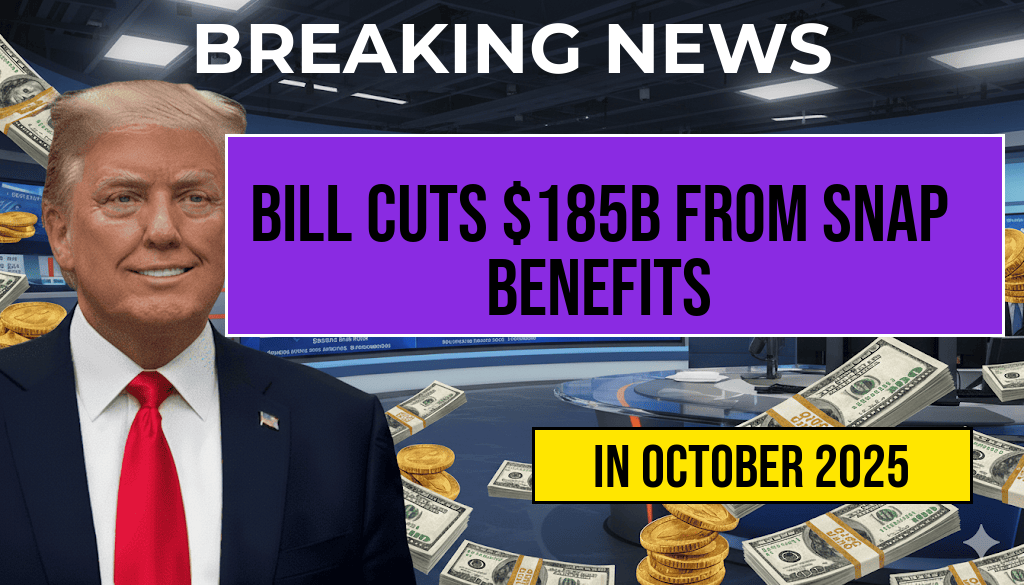Shaky Safety Net: Bill Cuts $185 Billion from Food Assistance—Impact on Your $546 Two-Person SNAP Benefits
A recent legislative move is reshaping the landscape of food assistance programs across the United States, with the federal government implementing a sweeping $185 billion reduction in funding for the Supplemental Nutrition Assistance Program (SNAP). This overhaul, driven by the new budget legislation, is expected to significantly tighten eligibility criteria and reduce benefit levels for millions of households. For a typical two-person household receiving around $546 per month, these cuts could mean losing access to crucial support during an already challenging economic period. As food insecurity persists nationwide, advocates warn that the diminished safety net may deepen disparities and strain local social services, raising questions about the long-term implications for vulnerable populations.
Understanding the Scope of the Cuts
The $185 billion reduction over the next decade is part of a broader effort to curb federal spending, but the specifics of how it will impact individual recipients are still unfolding. According to government estimates, the cuts will primarily stem from two sources:
- Lowering benefit amounts for current recipients based on revised income and expense calculations
- Restricting eligibility criteria, especially for able-bodied adults without dependents (ABAWDs)
For many households, these changes could result in monthly benefit reductions ranging from $50 to $150 or more. The U.S. Department of Agriculture (USDA) estimates that nearly 8 million individuals could see their SNAP benefits decrease or face eligibility barriers under the new rules.
Impact on Two-Person Households
For a standard two-person household, the average SNAP benefit hovers around $546 per month. Under the new policy adjustments, some families might see their benefits shrink by approximately 20%, potentially losing $100 or more each month. This reduction can have immediate consequences, forcing families to make difficult choices between paying for groceries, utilities, or other essentials.
A recent analysis from the Center on Budget and Policy Priorities highlights that such cuts could push an estimated 2 million households deeper into food insecurity, especially those already living paycheck to paycheck. For these families, a $546 benefit was often a lifeline to maintain basic nutrition, and its diminishment could lead to increased reliance on food banks, community aid, or even skipping meals.
Broader Societal and Economic Consequences
The ripple effects of these reductions go beyond individual households. Food insecurity is linked to poorer health outcomes, lower productivity, and increased healthcare costs. When families have less access to nutritious food, children may experience developmental setbacks, and adults face heightened risks of chronic illnesses such as diabetes and hypertension.
Local food banks and community organizations anticipate a surge in demand as fewer households qualify for assistance. The Food Research & Action Center (FRAC) warns that these cuts may undo years of progress in reducing hunger, especially in vulnerable communities historically marginalized by systemic inequities.
Policy Perspectives and Criticisms
Critics argue that the cuts reflect an ideological shift away from social safety nets designed to support economic stability. Senator Elizabeth Warren described the measure as “a blow to millions of Americans struggling to put food on the table.” Many advocates emphasize that the pandemic-era expansions helped cushion economic shocks but are now being rolled back in ways that threaten to reverse these gains.
However, proponents of the legislation argue that the reforms are necessary to prevent abuse and ensure the program remains fiscally sustainable. They point to efforts to streamline application processes and crack down on fraud as ways to improve program efficiency without significant benefit reductions.
What This Means for Your Benefits
| Household Size | Average Monthly SNAP Benefit | Estimated Reduction under New Policy |
|——————|——————————|————————————-|
| Two | $546 | Up to <$446> (approximate 20% cut) |
| Family of Four | $680 | Up to $560 |
| Single Adult | $250 | Up to $200 |
For many families, the change translates directly into less purchasing power, forcing tough choices about nutrition and economic stability. Households that were already on the edge may find themselves forced to seek additional assistance or cut corners on their food budgets.
Looking Ahead
State and local agencies are preparing for the transition, but the scale of the cuts raises concerns about capacity and effectiveness of support systems. Some policymakers are advocating for targeted reforms that protect the most vulnerable, while others emphasize fiscal responsibility.
Consumers are encouraged to review their eligibility and benefits regularly and seek assistance from local agencies if they encounter difficulties. Meanwhile, community organizations continue to call for a balanced approach that safeguards access to essential food resources amid ongoing economic challenges.
Sources and Further Reading
- Wikipedia: SNAP
- Forbes: Food Assistance Cuts and Their Effects
- Center on Budget and Policy Priorities
Frequently Asked Questions
What are the main changes to the SNAP program in the recent bill?
The recent bill cuts $185 billion from food assistance programs, significantly impacting the SNAP benefits for millions of families, including reducing the typical $546 benefit for a two-person household.
How will these cuts affect the daily food security of recipients?
With the reduction in SNAP benefits, many recipients may struggle to afford sufficient nutritious food, potentially leading to increased food insecurity and financial hardship.
Who will be most impacted by the SNAP benefit reductions?
Low-income families, elderly individuals, and people with disabilities relying heavily on SNAP benefits are likely to face the greatest impact from these funding cuts.
Are there any alternative assistance programs available for those affected?
Recipients seeking additional support can explore local food banks, nutrition programs, and community resources. Some states may offer supplemental aid or emergency assistance options.
What can I do if I am worried about losing my SNAP benefits?
It is advisable to stay informed about policy updates, reach out to local assistance agencies, and consider applying for additional support programs if available. Advocacy and community engagement can also help influence policy decisions.

Leave a Reply